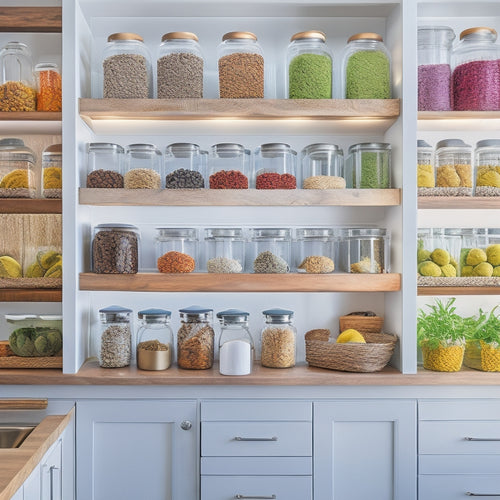
Revolutionize Food Storage: Tips, Methods, & More
Share
Proper food storage is vital for maintaining freshness, quality, and safety. To revolutionize food storage, it's vital to utilize the right products, such as high-density freezer bags and reclosable containers, designed to prevent spoilage and maintain quality. Mastering techniques like refrigeration, freezing, canning, vacuum sealing, and dehydration can also greatly extend shelf life. Additionally, ideal storage conditions, including controlled temperature, humidity, and light exposure, play a crucial role in preserving food. By combining these elements, you can create a dependable food storage system that guarantees your food stays fresh and healthy. Explore further to discover more innovative strategies for ideal food storage.
Key Takeaways
• Invest in high-quality food storage products, such as high-density freezer bags and reclosable bags, to maintain food freshness and quality.
• Master various food storage techniques, including refrigeration, freezing, canning, vacuum sealing, and dehydration, to preserve food effectively.
• Control temperature, humidity, and light exposure to create optimal storage conditions that prevent spoilage and bacterial growth.
• Implement an organized labeling system to ensure easy identification and efficient storage, reducing confusion and promoting kitchen functionality.
• Combine high-quality products, mastered techniques, and optimal conditions to create a reliable food storage system that guarantees freshness and safety.
Essential Food Storage Products
Stocking up on the right food storage products is necessary to maintaining a well-organized and efficient kitchen. High-quality essentials like high density freezer storage bags, deli bags, and reclosable bags form the backbone of a reliable food storage system. These food storage bags are designed to keep food fresh, prevent spoilage, and maintain quality.
Effective organization is also vital, and using the right bags can help streamline kitchen operations. Labeling these bags ensures easy identification, promoting efficiency and reducing confusion.
Mastering Food Storage Techniques
Proper food storage techniques are essential to maintaining the quality and safety of ingredients. Mastering various methods such as refrigeration, freezing, canning, vacuum sealing, and dehydration is necessary for best food preservation. By understanding the strengths and limitations of each method, individuals can choose the most effective approach for their specific needs.
Refrigeration is ideal for short-term storage of perishable items, while freezing provides long-term preservation for a wide range of foods.
Canning and vacuum sealing offer airtight protection against contaminants, making them suitable for long term storage.
Dehydration, on the other hand, is a low-cost method that removes moisture, preventing bacterial growth and spoilage.
Mastering these techniques enables individuals to enjoy their favorite foods year-round, while maintaining food safety and quality.
Optimal Food Storage Conditions
Optimal food storage conditions, characterized by controlled temperature, humidity, and light exposure, play an important role in maintaining the quality and safety of stored food items.
The ideal temperature for storing food varies depending on the type, but generally falls between 32°F and 40°F (0°C and 4°C) for refrigeration and -18°C or lower for freezing.
Humidity control is also vital, as high humidity can lead to mold and bacterial growth.
Light exposure should be minimized, as it can cause spoilage and degradation.
Frequently Asked Questions
Can I Reuse Plastic Bags for Food Storage?
When considering reusing plastic bags for food storage, prioritizing safety and hygiene is paramount. While reusing containers can be a sustainable option, thorough cleaning and sanitizing are necessary to prevent cross-contamination and foodborne illnesses.
How Do I Get Rid of Odors in Storage Containers?
To eliminate odors in storage containers, employ odor elimination methods like washing with soap and hot water, then drying thoroughly. Apply freshness preservation techniques, such as using baking soda or activated charcoal, to absorb and neutralize lingering smells.
Are Glass Containers Better Than Plastic for Storage?
Glass containers are a superior choice over plastic for storage due to their eco-friendly and non-porous nature, reducing health concerns associated with chemical leaching and bacterial growth, ensuring a safer and more sustainable storage solution.
Can I Store Cooked Food in the Same Container It Was Cooked In?
When storing cooked food, prioritizing food safety is crucial by transferring it to a clean, sanitized container to prevent cross-contamination, regardless of the original cooking container's material, ensuring a safe and healthy food storage practice.
How Often Should I Clean My Food Storage Areas?
Clean your food storage areas regularly, ideally every 1-2 weeks, to prevent cross-contamination and spoilage; maintain organization by categorizing items, labeling containers, and ensuring easy access to promote a safe and efficient storage environment.
Related Posts
-

Innovative Lazy Susan Storage Solutions
Innovative Lazy Susan storage solutions are a revolutionary advancement for any space, especially in kitchens. They m...
-

Under-Sink Storage Bins for Organized Kitchens
Under-sink storage bins are your best bet for an organized kitchen. They maximize unused cabinet space and enhance it...
-

Creating More Space in a Tiny Kitchen
You can alter your tiny kitchen into a more spacious haven by utilizing smart storage solutions. Install wall-mounted...


